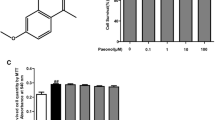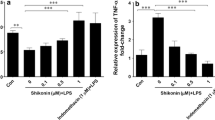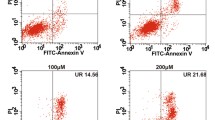Abstract
Background
Fibroblast-like synoviocytes (FLS) play an essential role in the pathogenesis of chronic inflammatory diseases, such as rheumatoid arthritis. Paeonol (Pae) is a phenolic compound found in many traditional Chinese medicine remedies. However, the effects of Pae on TNF-α-stimulated FLS and the underlying molecular mechanism are unknown. In this study, we aimed to investigate the anti-proliferative and anti-inflammatory effect of Pae against activated FLS.
Materials and methods
Rheumatoid arthritis FLS (RA-FLS) were pre-treated with different doses (25, 50, and 100 µM) of Pae or miR-155 inhibitor for 30 min or transfected with miR-155 mimic, and then treated with 50 ng/mL of tumor necrosis factor alpha (TNF-α) for 1 h. Cells that were untreated served as control. At 24 h after drug pretreatment, the proliferation of FLS was detected using the MTT assay. The concentrations of interleukin IL-6 and IL-1β in cell culture supernatant were examined by enzyme-linked immunosorbent assay (ELISA), and mRNA levels of Foxo3 and miR-155 expression in FLS were quantified by reverse transcription-polymerase chain reaction (RT-PCR). Protein expressions of forkhead box O3 (FOXO3), cyclin D1, and c-Myc were detected by Western Blot.
Results
TNF-α induced the proliferation of FLS, whereas Pae inhibited this proliferation in a dose-dependent manner. Pae attenuated TNF-α-induced production of IL-6 and IL-1β, and inhibited the expression of miR-155 in a dose-dependent manner. In addition, miR-155 inhibitor decreased TNF-α-induced proliferation of FLS, and attenuated TNF-α-induced production of IL-6 and IL-1β. In addition, pretreatment with different doses of Pae or miR-155 inhibitor markedly attenuated TNF-α-induced decrease in protein expression of FOXO3 in FLS. Mechanistic studies revealed FOXO3 as miR-155-5p direct target and inhibition of FOXO3 led to the abolishment of Pae protective effects.
Conclusions
Paeonol protected against TNF-α-induced proliferation and cytokine release of FLS by decreasing the expression of miR-155 and upregulating its target FOXO3.





Similar content being viewed by others
References
Chang SK, Gu Z, Brenner MB. Fibroblast-like synoviocytes in inflammatory arthritis pathology: the emerging role of cadherin-11. Immunol Rev. 2010;233:256–66.
Dasuri K, Antonovici M, Chen K, Wong K, Standing K, Ens W, El-Gabalawy H, Wilkins JA. The synovial proteome: analysis of fibroblast-like synoviocytes. Arthr Res Ther. 2004;6:R161–R168.
Bartok B, Firestein GS. Fibroblast-like synoviocytes: key effector cells in rheumatoid arthritis. Immunol Rev. 2010;233:233–55.
Ducki S, Hadfield JA, Lawrence NJ, Zhang X, McGown AT. Isolation of paeonol from Arisaema erubescens. Planta Med. 1995;61:586–7.
Deng C, Yao N, Wang B, Zhang X. Development of microwave-assisted extraction followed by headspace single-drop microextraction for fast determination of paeonol in traditional Chinese medicines. J Chromatogr A. 2006;1103:15–21.
Zhou J, Zhou L, Hou D, Tang J, Sun J, Bondy SC. Paeonol increases levels of cortical cytochrome oxidase and vascular actin and improves behavior in a rat model of Alzheimer’s disease. Brain Res. 2011;1388:141–7.
Chou TC. Anti-inflammatory and analgesic effects of paeonol in carrageenan-evoked thermal hyperalgesia. Br J Pharmacol. 2003;139:1146–52.
Kim SH, Kim SA, Park MK, Kim SH, Park YD, Na HJ, Kim HM, Shin MK, Ahn KS. Paeonol inhibits anaphylactic reaction by regulating histamine and TNF-alpha. Int Immunopharmacol. 2004;4:279–87.
Kong LD, Cheng CH, Tan RX. Inhibition of MAO A and B by some plant-derived alkaloids, phenols and anthraquinones. J Ethnopharmacol. 2004;91:351–5.
Brennan FM, McInnes IB. Evidence that cytokines play a role in rheumatoid arthritis. J Clin Invest. 2008;118:3537–45.
Kyung Chang S, Gu Z, Brenner MB. Fibroblast-like synoviocytes in inflammatory arthritis pathology: the emerging role of cadherin-11. Immunol Rev. 2010;233:256–66.
Yamanishi Y, Firestein GS. Pathogenesis of rheumatoid arthritis: the role of synoviocytes. Rheum Dis Clin N Am. 2001;27:355–71.
Noss EH, Brenner MB. The role and therapeutic implications of fibroblast-like synoviocytes in inflammation and cartilage erosion in rheumatoid arthritis. Immunol Rev. 2008;223:252–70.
Tak PP, Kalden JR. Advances in rheumatology: new targeted therapeutics. Arthr Res Ther. 2011;13:1.
Zhang W, Dai S-M. Mechanisms involved in the therapeutic effects of Paeonia lactiflora Pallas in rheumatoid arthritis. Int Immunopharmacol. 2012;14:27–31.
O’Connell RM, Rao DS, Baltimore D. microRNA regulation of inflammatory responses. Annu Rev Immunol. 2012;30:295–312.
Faraoni I, Antonetti FR, Cardone J, Bonmassar E. miR-155 gene: a typical multifunctional microRNA. Biochim Biophys Acta. 2009;1792:497–505.
Sonkoly E, Janson P, Majuri ML, Savinko T, Fyhrquist N, Eidsmo L, Xu N, Meisgen F, Wei T, Bradley M, Stenvang J, Kauppinen S, Alenius H, Lauerma A, Homey B, Winqvist O, Stahle M and Pivarcsi A. MiR-155 is overexpressed in patients with atopic dermatitis and modulates T-cell proliferative responses by targeting cytotoxic T lymphocyte-associated antigen 4. J Allergy Clin Immunol 2010;126:581–589, e581–520.
Moore CS, Rao VT, Durafourt BA, Bedell BJ, Ludwin SK, Bar-Or A, Antel JP. miR-155 as a multiple sclerosis-relevant regulator of myeloid cell polarization. Ann Neurol. 2013;74:709–20.
Brunet A, Bonni A, Zigmond MJ, Lin MZ, Juo P, Hu LS, Anderson MJ, Arden KC, Blenis J, Greenberg ME. Akt promotes cell survival by phosphorylating and inhibiting a Forkhead transcription factor. Cell. 1999;96:857–68.
Ekoff M, Kaufmann T, Engstrom M, Motoyama N, Villunger A, Jonsson JI, Strasser A, Nilsson G. The BH3-only protein Puma plays an essential role in cytokine deprivation induced apoptosis of mast cells. Blood. 2007;110:3209–17.
Skurk C, Maatz H, Kim HS, Yang J, Abid MR, Aird WC, Walsh K. The Akt-regulated forkhead transcription factor FOXO3 controls endothelial cell viability through modulation of the caspase-8 inhibitor FLIP. J Biol Chem. 2004;279:1513–25.
Castrillon DH, Miao L, Kollipara R, Horner JW, DePinho RA. Suppression of ovarian follicle activation in mice by the transcription factor FOXO3. Science. 2003;301:215–8.
Author information
Authors and Affiliations
Corresponding author
Additional information
Responsible Editor: Yoshiya Tanaka.
Ning Liu and Xue Feng contributed equally to this work.
Rights and permissions
About this article
Cite this article
Liu, N., Feng, X., Wang, W. et al. Paeonol protects against TNF-α-induced proliferation and cytokine release of rheumatoid arthritis fibroblast-like synoviocytes by upregulating FOXO3 through inhibition of miR-155 expression. Inflamm. Res. 66, 603–610 (2017). https://doi.org/10.1007/s00011-017-1041-7
Received:
Revised:
Accepted:
Published:
Issue Date:
DOI: https://doi.org/10.1007/s00011-017-1041-7




